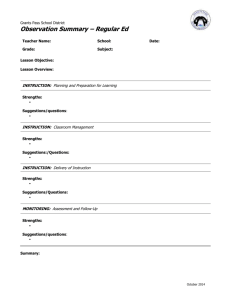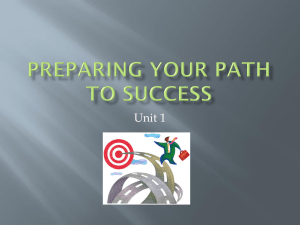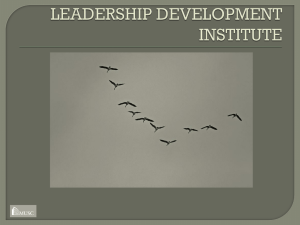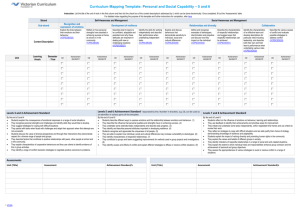The Project Success Blueprint - Cognoscenti Business Psychologists
advertisement
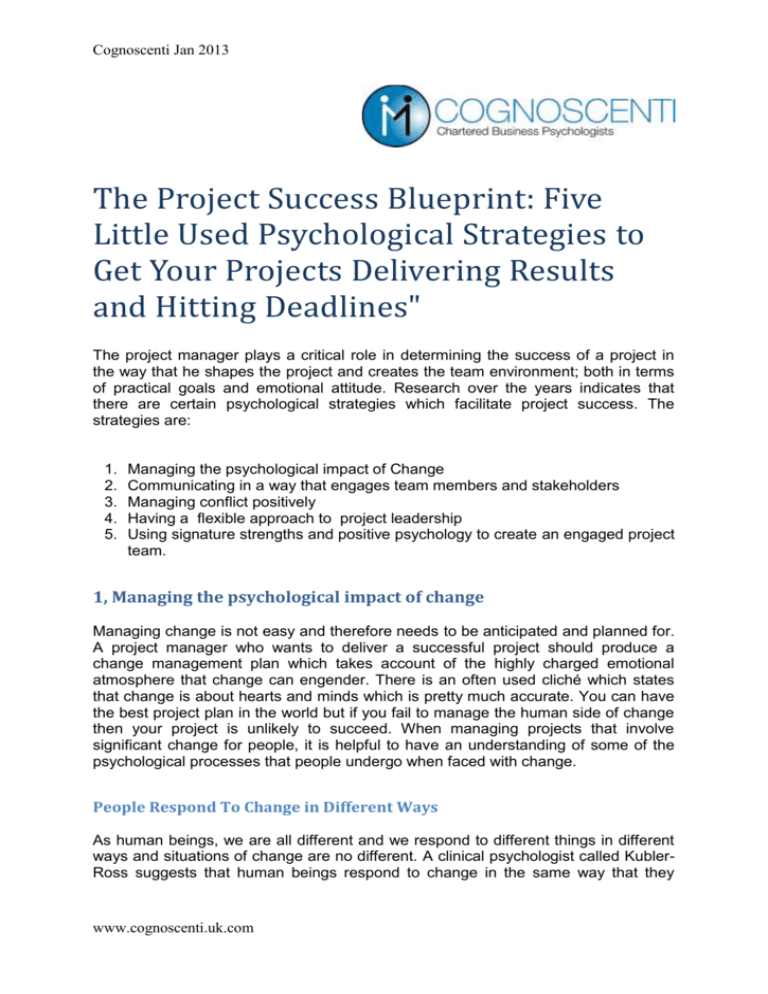
Cognoscenti Jan 2013 The Project Success Blueprint: Five Little Used Psychological Strategies to Get Your Projects Delivering Results and Hitting Deadlines" The project manager plays a critical role in determining the success of a project in the way that he shapes the project and creates the team environment; both in terms of practical goals and emotional attitude. Research over the years indicates that there are certain psychological strategies which facilitate project success. The strategies are: 1. 2. 3. 4. 5. Managing the psychological impact of Change Communicating in a way that engages team members and stakeholders Managing conflict positively Having a flexible approach to project leadership Using signature strengths and positive psychology to create an engaged project team. 1, Managing the psychological impact of change Managing change is not easy and therefore needs to be anticipated and planned for. A project manager who wants to deliver a successful project should produce a change management plan which takes account of the highly charged emotional atmosphere that change can engender. There is an often used cliché which states that change is about hearts and minds which is pretty much accurate. You can have the best project plan in the world but if you fail to manage the human side of change then your project is unlikely to succeed. When managing projects that involve significant change for people, it is helpful to have an understanding of some of the psychological processes that people undergo when faced with change. People Respond To Change in Different Ways As human beings, we are all different and we respond to different things in different ways and situations of change are no different. A clinical psychologist called KublerRoss suggests that human beings respond to change in the same way that they www.cognoscenti.uk.com Cognoscenti Jan 2013 respond to bereavement. People typically go through five stages i.e. Anger, Bargaining, Depression and Acceptance. a, Denial This is the typical ‘head in the sand’ reaction that you often see when managing change. People convince themselves that the change will not happen if they ignore it. This denying of the truth makes communication about the project particularly challenging and the project manager will have to ensure that he uses a variety of communication mediums and that the communication is consistent and persistent. This stage is a temporary self-defence mode that people go into when faced with change. This stage usually passes fairly quickly and is replaced by stage two, which is ‘Anger’. b, Anger Once people realise that ‘Denial’ is no longer viable and start to feel angry and aggrieved that the change is going to happen. You will hear comments like “this sort of thing has been tried before and it didn’t work then!” Persistent and consistent communication through a range of mediums can be helpful in moving this stage along. Individuals soon realise that they cannot maintain their anger indefinitely as colleagues who are more positive about the change become tired of them. This tends to move them on to the next stage which is ‘Bargaining’. c, Bargaining This is where the individual tries to do deals e.g. he may come up with a plan for his manager or team that involves working in a slightly different way as he thinks this may prevent the change from happening. These types of bargaining initiatives rarely work and this then leads to the next stage, which is ‘Depression’. d, Depression This is where the individual is starting to realise that the change is going to go ahead anyway and that there is nothing that he can do, personally, to prevent it. The individual becomes low in mood at this time and may become socially withdrawn at work. This stage is an important part of the ‘Grieving’ process as it allows the individual to prepare himself or the next stage which is ‘Acceptance’. Project managers need to provide extra support to staff during this phase and try to help them see the benefits of the change. e, Acceptance At this stage, the individual starts to accept the change and accept that it will happen and that he might as well ‘go with the flow’. Not everyone goes through the above stages in the same order nor necessarily experiences all of the stages but this model www.cognoscenti.uk.com Cognoscenti Jan 2013 enables the project manager to have an understanding of the types of emotions that people are likely to be experiencing in response to his project. Project managers and other managers who are not aware of this model often interpret the emotions that they witness as ‘Resistance’ and view them negatively as a problem to be resolved as opposed to a guide as to where they need to provide additional support. Resistance to Change The model shows us that we should anticipate resistance to change as it is part of the learning and adjustment process those individuals undergo in response to change situations. Remember though that the stages in the Kubler-Ross model are not about change per se but about situations of loss i.e. people will go through these stages when they think they are about to lose something or have lost something. In any change situation there are always people who perceive themselves as gaining something and people who perceive themselves as losing something. Obviously, the ones who see themselves as losing something are more likely to go through the stages described above. It is important to identify the potential ‘losers’ in any change project as this will enable you to anticipate any likely ‘resistance’. Obviously, you will need to ensure that sufficient effort is put into working with this group in order to prevent any delays or sabotage to your project. Dealing with Resistance The key to dealing effectively with Resistance to Change is to understand the psychological processes that are going on and anticipate what is likely to happen at each stage of your project plan. In this way, you can build in the necessary support activities to ensure that people’s fears addressed and that the required change is supported. Readiness to Change There is a second psychological process associated with change management which is called ‘Readiness to Change’. This process describes a person’s emotional readiness to change. In the previous section, we talked about people who perceive a loss in change undergoing five phases of emotional adjustment in response to the change. It is important to recognise, however, that everyone will have a ‘Readiness to Change’ or ‘Tipping’ point which means that you cannot assume that those people included in the change process who do not perceive a loss will change exactly when you need them to. ‘Readiness to Change’ is about the motivation of the individual to change, it is about their decision making processes and their wider emotions and cognitions. The responsibility of the project manager is to ensure that they facilitate this psychological and emotional readiness as much as possible by taking the concept of ‘Readiness to Change’ into account when planning for change and putting processes in place to help ensure that people: www.cognoscenti.uk.com Cognoscenti Jan 2013 Understand the change and its implications for them Feel engaged in the change i.e. feel that they have a real say in it Feel that there is sufficient openness, honesty and transparency to feel that they can trust the agents of change Feel that they have something to gain from it. Feel supported and that someone is on their side and is looking out for them 2, Communicating in a way that engages team members and stakeholders Most projects will have a communication plan and these plans usually detail the highlight reports that will be sent to various stakeholders at different times during the project life cycle. Communication through reports is useful, in terms of, keeping stakeholders up to date with what is happening on the project but it is unlikely to engage stakeholders and gain the psychological buy-in that you need in order to make your project a success. The research indicates that in order for stakeholders to feel engaged, they have to experience the following: A sense of feeling valued and involved. Being involved in decision making. Having the freedom to voice ideas and knowing that the project manager will listen Feeling enabled to perform well. In order to make these things happen, the project manager is going to have to practice some key behaviours in his interactions with stakeholder’s i.e. Relationship building Honesty and openness Building shared ownership Building understanding ‘Relationship Building’ is about taking the time to build good relationship with stakeholders. Too many project managers operate at a transactional level where they only communicate with stakeholders when they actually want something from them. The key is to build harmonious relationships where the stakeholder feels valued and nurtured. Making your stakeholders feel valued and involved is about finding out about their needs and objectives and sharing your aspirations with them. This ensures that you understand what they are trying to achieve both generally and from the project. It is necessary to invest time in demonstrating a genuine interest in how stakeholders think and feel about their work and the project. This will provide you with a better understanding of what really motivates them. Be enthusiastic, about your project. Emotions transfer to those around us so if you are enthused about your project, some of that will rub off on your stakeholders. Honesty and Openness are crucial to building a good relationship and it is important to share news warts and all. As human beings, we can have a tendency to shy away from bad news or play it down. This is not constructive in the long term; www.cognoscenti.uk.com Cognoscenti Jan 2013 particularly with projects. It is better to be open about any negative aspects of the project and to work with the stakeholder to identify any ways of mitigating potential downsides. The same goes for helpful suggestions that stakeholders make regarding your project. If you have no intention of taking the suggestions on board, don’t just ignore the suggestions (remember that you are trying to make stakeholders feel engaged and involved) provide the stakeholder with feedback (preferably face to face if possible) as to why his suggestions will not work in your opinion. This provides you with a further opportunity to engage the stakeholder and get their buy in because you can ask them for any additional suggestions that they may have which will overcome the problems that their original suggestion created. Building shared ownership Basically, building shared ownership is about using the information that you gather when building the relationship with your stakeholder to identify any common goals or aspirations around the project so that you have common ground. The next stage is to jointly agree on a way forward so that your stakeholder has as much invested in the goal as you do. 3, Managing conflict positively Project management has a huge propensity for conflict simply because there are numerous independent relationships and projects often cross organisational and managerial boundaries. In addition, the, often tight, time constraints of project activities can bring project teams into conflict with stakeholders who also have to deliver day-to-day business as well. Because of this, it is very useful for project managers to be able to anticipate likely conflict but more importantly to be able to deal with conflict when it does occur, in a way that promotes harmony and the achievement of project targets. This will avoid the stalemates and damaged relationships that can delay and derail projects. Recognising Conflict Serious conflict is usually very visible and difficult to miss, however, by that point, key relationships may already have been soured or spoiled. Like a lot of things, conflict is often easier to resolve if it is caught in the early stages. There are usually warning signs that ‘everything in the garden is not rosy’ and it is important that project managers are vigilant and look for any signs that there is conflict. Some of the signs of conflict can be quite subtle e.g. Delays in responding to communications concerning the project Persistent negativity ‘Us and Them’ mentality Unwillingness to share information or ideas Lack of interest in the project Questioning everything Pretending not to understand things that appear to be self explanatory www.cognoscenti.uk.com Cognoscenti Jan 2013 When the elements listed above occur, it can be for very good reasons but any one of them or in fact any combination of them can also indicate negativity or early warning signs of conflict. Good conflict resolution should have ‘Win Win’ at its core but it is important to remember that the key in resolving any conflict is to understand each parties' underlying interests, needs and values instead of focusing on each parties’ positions. Creating a positive and Supportive Environment. It is important to bring the parties in conflict together in an environment that is conducive to resolving the conflict. It is usually better not to use an existing project meeting for this activity as you may need to create a little bit of distance away from the project in order to encourage people to participate in your conflict resolution process. The timing of the meeting may need some consideration and you will need to think carefully about how you ‘market’ it to involved parties in order to ensure, firstly that they attend and secondly that they will be open to discussion Remember that Conflict is essentially about attitudes and behaviours which means that you need to encourage people to share their attitudes so that you can all understand why everyone is behaving in the way that they are and subsequently bring about change. A coaching approach such as the ‘GROW’ model provides project managers with a framework to explore the root causes of conflict by exploring how all parties think and feel about ‘the problem’ and facilitate individual and team development at the same time. Throughout the meeting, try to read the non-verbal signs of communication as well as taking note of what is actually said. This will give you a more accurate picture of the emotional environment. You will also need to use emotional intelligence you manage your own emotions and maintain a calm and neutral position, which will allow you to relate better to others. If you allow yourself to get caught up in the emotions of others, you will lose your objectivity and will lose the trust of some parties to the meeting. When trying to manage conflict, it is useful to have the following two in the back of your mind. Separate the person from the problem - separate the problem from the person and jointly focus on the problem and how to resolve it. Focus on interests not positions - Stakeholders are more likely to want to understand where you are coming from if you have demonstrated a genuine interest in their requirements. www.cognoscenti.uk.com Cognoscenti Jan 2013 4, Having a Flexible Approach to Project Leadership “Project management is a leader- intensive undertaking” and as we have already seen from the research explored earlier, strong leadership is essential to the success of projects. Consequently the question of what type of leadership is needed is a crucial question in any leadership task. There are numerous models of leadership, some of which are more relevant to project management than others. Some of the earlier theories of leadership such as the ‘The Managerial Grid’ and ‘Situational Leadership’ focus on the split between a focus on task a focus on people. The ‘Situational Leadership’, style also raised the idea that a leader may have to change the leadership style that he uses to accommodate the different needs of followers. These approaches appear well suited to the older style of project leadership, where the emphasis was on control and risk management. Modern day project management, however, is much more about motivating and engaging people. This means that the more recent styles of leadership style are more suited to modern day project management e.g. ‘Transformational Leadership’, ‘Emotionally Intelligent Leadership’ and ‘Authentic Leadership’. These leadership styles are all slightly different in focus but they thing that they have in common, is that, they emphasise creating a shared vision to motivate people. They are about building good relationships through honesty and trust and they are about working from a value base. Which Leadership Style Should Project Managers Use? Leadership is more of an art than a science and there is no formula that tells us which leadership style to use in which situation. The important thing, however, is that you are aware of the leadership style(s) that you are most comfortable with and recognise when it is appropriate to use that one and when you need to step out of your comfort zone and use an alternative leadership style. To take an example, from what we have seen of leadership styles so far, the more democratic, affiliative, visionary types of style are going to gain you the most ‘buy-in’ from your project team and stakeholders because they facilitate good relationships. The more task focused, commanding types of leadership style are likely to be most useful when you have a crisis to deal with or perhaps where team members are not ready or capable of performing at the appropriate level. Many of the characteristics of the emotionally intelligent leadership style are also necessary in order to be a good change manager i.e. you need to be aware of your own emotions and those of people around you. It is also useful to know how to use your emotions to influence those around you. Our emotions transfer to those around us so if you are positive and enthusiastic; some of this will rub off on your team/stakeholders. Below are some questions that you may wish to reflect on to help you consider your most and least comfortable leadership. www.cognoscenti.uk.com Cognoscenti Jan 2013 Questions for Reflection 1. What is your preferred style of leadership i.e. what style have you felt most comfortable with in the past? 2. Which style(s) of leadership have you felt most uncomfortable with in the past? 3. What development needs will you have in changing your leadership style? 4. What triggers will you use to help you know when you should change your leadership style? 5. How will you monitor when you are changing from one management style to another throughout the life of the project and how will you learn from that experience? It is probably also worth adding a note of caution here for project managers; particularly those that come from a non people-focused background. Because projects are all about deliverables and timescales it is sometimes very easy to be seduced by the glory of focusing on the project plan and the many tasks that have to be delivered. It is very important to constantly remind yourself that every additional moment that you are focused on tasks is one less moment focused on the people side of the equation; which at the end of the day is usually the most unpredictable and volatile element of the whole project management equation. 5, Using signature strengths and positive psychology to create an engaged project team. The process of building a project team should be concerned with helping the team to identify and focus on its objectives whilst facilitating an environment in which team members can develop and function collectively as a team. Building the Project Team The starting point for any Project Manager, once the team has been appointed is to start getting to know the team members as individuals and identifying their relative strengths. There are many different ways in which this could be achieved. How People Relate to Each Other in Teams Compatibility in teams is crucial to their effectiveness; let us go on to look at some ways in which the potential interrelationships between team members can be explored. There are various tools that a project manager can use to start gaining a better understanding of individual team member’s preferred ways of working and particular strengths that they can contribute to the team e.g. ‘The Myers Briggs Type Indicator ‘and Positive Psychology. www.cognoscenti.uk.com Cognoscenti Jan 2013 In order to build an effective team, it is necessary to know something of the individuals that comprise the team e.g. their preferred ways of doing things and their strengths. One tool that has been used extensively with teams to help them understand each others styles and preferences has been the ‘Myers Briggs Type Indicator (MBTI). The MBTI is an instrument that helps people to “appreciate important differences between people and understand how different types can work together in a complementary way. It is necessary to be trained in the use of the MBTI before attempting to utilise it with teams. Signature Strengths Research carried out by (Seligman 2004) identified twenty- four strengths or Virtues that he named ‘Signature Strengths’. Seligman found that his twenty-four signature strengths were found across all cultures in the world. He suggests that we all have a subset of these twenty four strengths that become our own signature strengths. He also suggests that, as human beings, we are far happier and more productive, whether in work or any other environment, if we are engaged in tasks that enable us to utilise our signature strengths. It follows then, that if you can identify the signature strengths of your project team then you can allocate tasks in a way that utilises those strengths. This will help you create a more positive and more productive project team. There is a questionnaire on Seligman’s website (mentioned earlier) called the ‘Brief Strengths Test’ and you and your team members can complete this free of charge on-line. http://www.authentichappiness.sas.upenn.edu/Default.aspx How Can Positive Psychology Help You Create A Winning Project Team? Positive Psychology suggests that you should utilise the following to improve team performance and well-being: The Environment plays a part in influencing our emotions either negatively or positively. The brighter and more pleasant the environment, the more positive a mood will be created. If you need to generate creative and tolerant thinking then you need a bright and stimulating environment. Do not dwell on team failures or negative experiences as this will just reinstigate any associated negative emotions and will lower the mood of the team. Get team members to express gratitude e.g. if a team member or stakeholder has done something for them, encourage the team to acknowledge this. Gratitude increases positive feelings both in the giver and the recipient. Be aware of any pessimistic tendencies in your team and be mindful of them. Pessimistic tend to give up more easily i.e. they do not persevere as much as optimists. You may have to be prepared to give more encouragement to team members with pessimistic tendencies in order to boost their confidence and belief that they can succeed by persevering. Try to keep fun alive within the team but vary the experiences because people’s level of enjoyment soon habituates i.e. becomes satiated and the www.cognoscenti.uk.com Cognoscenti Jan 2013 quality of the experience diminishes. Keep it fresh. Research has shown that an element of surprise prevents pleasure from habituating. Where possible, try to ensure that you assign your project team members to tasks that best utilise their signature strengths, as they will be happier and more productive. Thank you for requesting this report. If you would like to ask any questions or if you feel that you need support with an organisational project, drop us a line on: Sharon@cognoscenti.uk.com or call us on 0161 344 5492/07771 870 547 www.cognoscenti.uk.com

